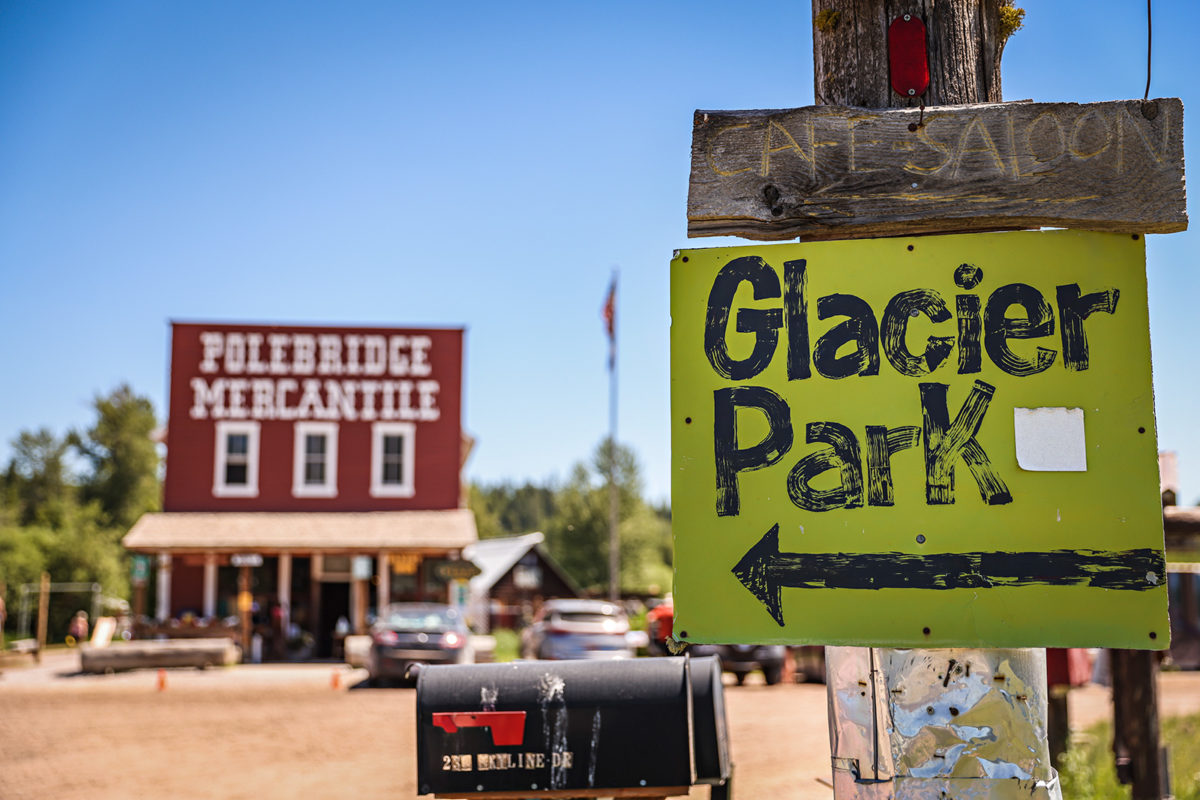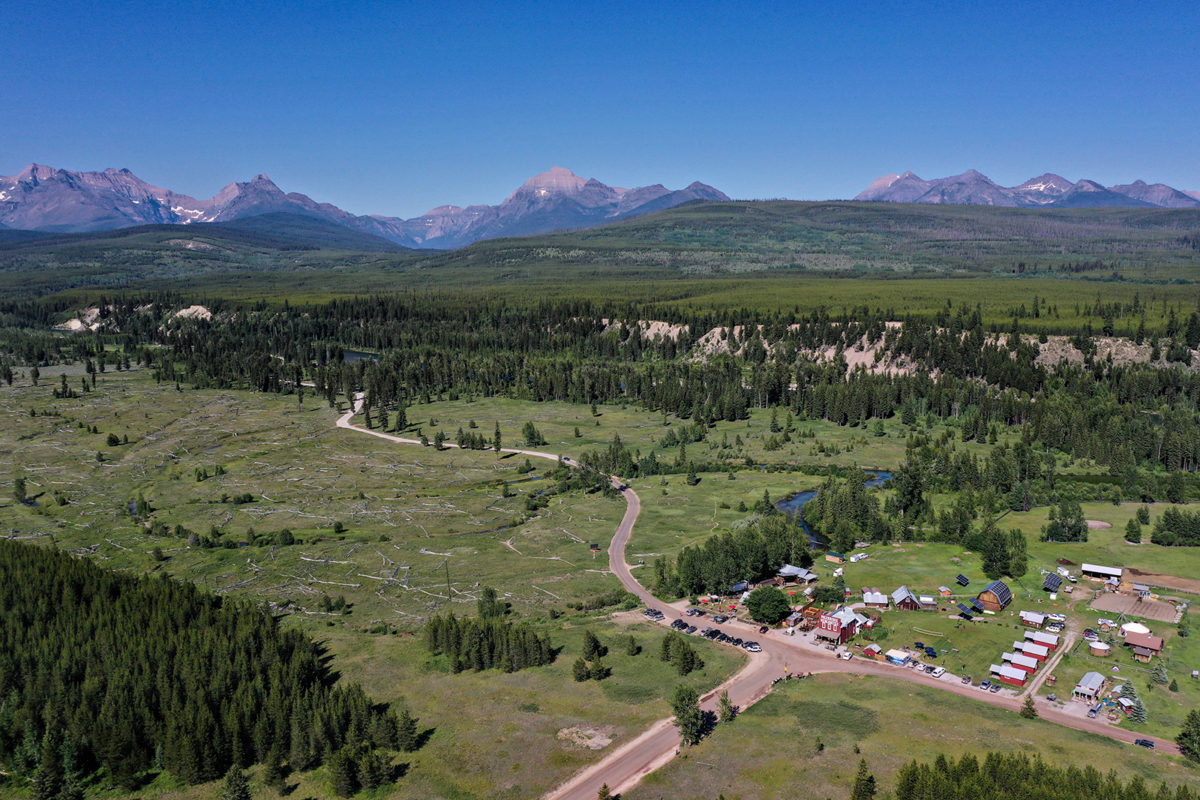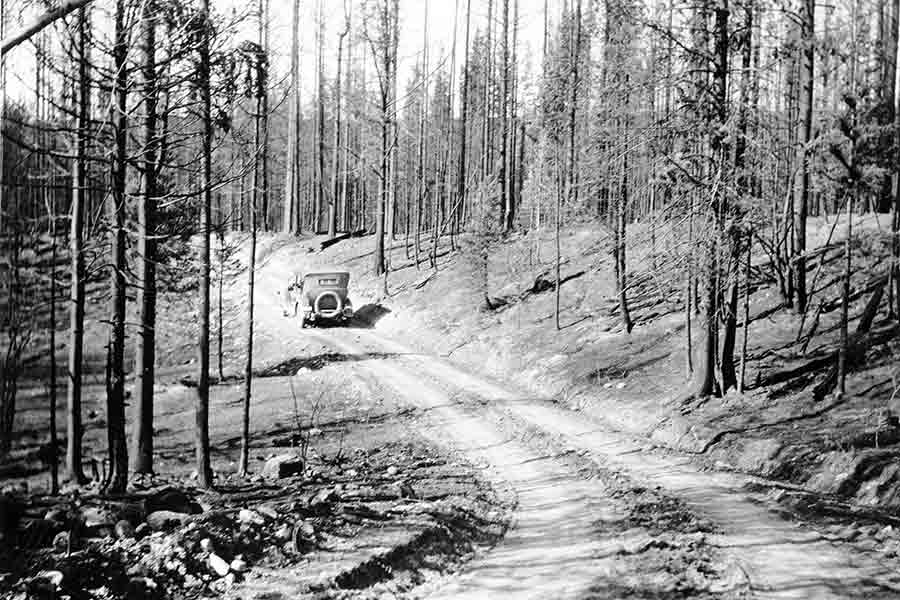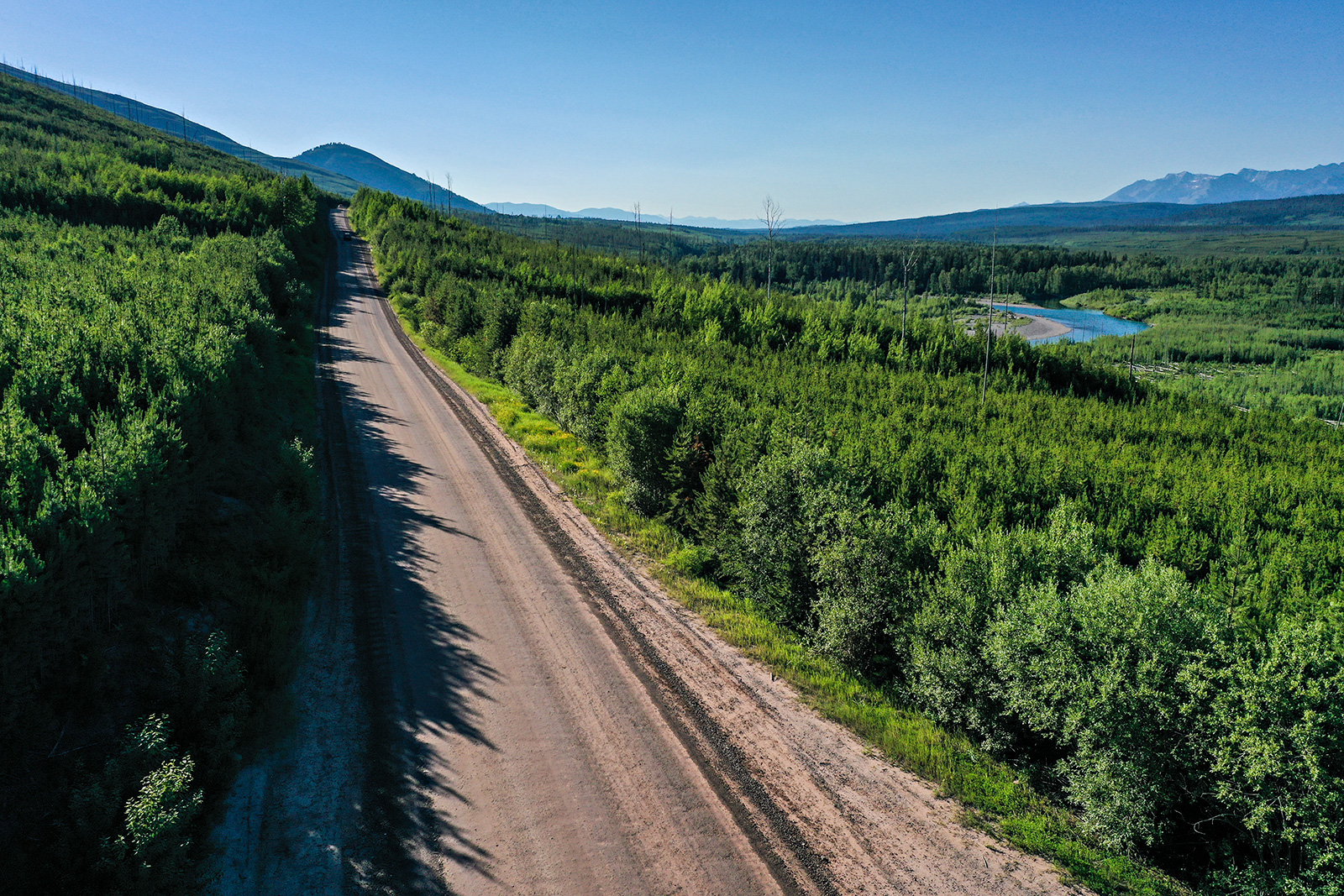Bob Graham doesn’t know exactly how many miles he’s logged on the gravel North Fork Road but estimating “more than a half-million miles” over the course of his 30 years of owning property in the rural scenic community doesn’t seem hyperbolic.
“I’ve got a truck that’s undrivable because of that road,” Graham said. “I’ve gone through so many shocks, innumerable tires, the underside’s been corroded away from the magnesium chloride treatment. Having to buy a new car is an expensive tax to keep the road unpaved. It’s just been so bad for so long that lots of us old timers are getting tired of it.”
Graham built his first cabin on his North Fork property in 1993 and lives there year-round — one of between 80 and 300 full-time North Fork residents, depending on who you ask and how they define “full-time.” He has also emerged as a leader among North Fork residents advocating for the paving of 10 miles of the North Fork Road from where the pavement currently ends just north of Blankenship Road to the intersection with Camas Road.
“I think I understand both sides of the picture, because I used to be on the other side,” Graham said. “The North Fork used to be quiet. It’s why we moved up there and probably why most people move up there. It’s the real middle of nowhere, a last best place kind of thing. But now there’s so many people, you have to see the writing on the wall, and I’ve realized that while I’d like the area to be totally mine like it was in the old days, that’s not the reality anymore.”
The North Fork Road leads to the small hamlet of Polebridge, with its iconic red mercantile, and to one of the more remote vehicle entrances to Glacier National Park. However, the park’s popularity in recent years has exposed even the least-trafficked entrance to a flood of visitors. In 2022, visitation to the Polebridge entrance peaked in July with 20,799 visitors, all utilizing the North Fork Road to get there.

Compare that to just 12 years prior, when a 2010 study of the North Fork corridor showed an average of 1,500 monthly visitors entering the park through Polebridge. That study was conducted to give stakeholders, government agencies and residents a comprehensive understanding of the road’s status, and to lay out possibilities for improving its potholed and wash-boarded lower stretch. The 2010 study considered potential options for improving the road, including a pavement project that was based on traffic counts at the time. However, moving forward with an improvement project has been too costly.
Until now.
Flathead County officials took the first steps that could lead to the eventual paving of the lower 10-mile stretch of the North Fork Road last month by applying for a Federal Lands Access Program (FLAP) grant for nearly $6 million. The grant will be used to conduct an environmental evaluation and begin the public involvement process to determine the best path forward, bringing an issue long divisive among North Fork residents to the forefront.
Graham helped organize a “Pave it to Camas” group of roughly 150 people who signed a petition in support of paving the lower stretch of road. He also worked with Flathead County Commissioner Brad Abell to gather letters of support, more than 30 of which were included in the county’s FLAP application.
“Having the road as crappy as it was for so many years, it was a boundary to access,” Graham said. “Now I feel that keeping it unpaved does keep people out, but it’s not my place to keep them out.”
The North Fork Road’s degradation as a barrier to entering the pristine North Fork landscape is commonly cited by those who wish to maintain its current state, including Flannery Freund, president of the North Fork Preservation Association, an organization dedicated to preserving the pristine ecosystem of the North Fork.
“It’s always been our argument that the lower section of road has been a natural filter,” Freund told the Beacon. “This has been such a historical issue just within our community, and it’s a really delicate one.”
The issue of paving stretches of the North Fork Road has been at the heart of the NFPA’s work for decades — residents founded the organization in 1982 in response to proposals to pave the road and develop a coal mine upstream across the Canadian border. Even the organization’s website — gravel.org — points to the desire to keep the road in its current state.

Freund co-owns Home Ranch Bottoms, a restaurant, bar and music venue, that sits on the only paved stretch of the North Fork Road north of Camas. She previously co-owned the Polebridge Mercantile from 2009 to 2014 and is also a member of the North Fork Road Alliance, a group of residents that opposes its paving. The North Fork Road Alliance has its own petition, which has gathered more than 250 signatures.
Freund said that while the issue is divisive among locals, there is an attitude that everyone understands “managing this really special place is of the utmost importance.”
“The discussions have been much uglier in the past,” she added. “Fifteen years ago, people couldn’t bring it up without steam coming out of their ears.”
Speaking for the North Fork Preservation Association, Freund said the biggest concern over paving any stretch of the road centers on the cumulative impacts. There’s already a project underway between Polebridge and the entrance to Glacier Park that involves resurfacing the road with asphalt millings. The stretch of road in front of the Mercantile and other businesses will undergo the same process this summer.
“Paving one section makes it that much more approachable to pave another section,” Freund said. “The biggest concern for the NFPA is cumulative impacts. I wonder how making a paved loop on the lower stretch of road will affect Red Meadow Loop, or Trail Creek, or put more pressure on the inside North Fork Road.”
In the FLAP application submitted by the county, paving the lower North Fork Road is heralded as a way to increase recreational opportunities. For cyclists, a paved surface would improve conditions along a 50-mile bike loop between Columbia Falls, West Glacier and the North Fork, while adding pullouts and parking spaces would increase river access for fishermen and boaters.
The Columbia Falls City Council has long favored paving the road to increase recreational access and to boost the town’s economy by funneling more visitors through downtown. A letter of support from the council was included in the county’s application.
Commissioner Brad Abell, whose district encompasses the North Fork, has been a driving force to bring the North Fork Road into the funding spotlight. Following his 2020 election, Abell said locals on both sides of the issues brought the lower road’s condition to his attention. In previous years, using a magnesium chloride treatment on the road has helped with dust control and preservation, but Abell said the county’s been unable to secure enough funding to do the amount of maintenance work required to keep the road from devolving, leading to him seek additional funding sources.
“To be honest paving this section of road would relieve a huge and costly burden from Flathead County and her taxpayers … I believe our piece of heaven has been discovered and people are going to show up to visit it and a lack of infrastructure and maintenance isn’t going to deter them,” Abell wrote in a letter to residents of the North Fork asking for comments.
Dave Prunty, the head of the Flathead County Road Department, estimates it costs around $300,000 to maintain the road every year, a cost that doesn’t always include regular magnesium chloride treatment.
Prunty said that the Montana Department of Transportation has indicated it will take over maintenance of the North Fork Road if it’s reconstructed to state standards — which means a paved surface.
Abell and Prunty both emphasized that the FLAP grant will primarily cover the National Environmental Policy Act (NEPA) study on the North Fork corridor, which will take approximately two years and considers the impacts of various improvement strategies on the primitive ecosystem bordering Glacier National Park, which harbors several species listed as threatened under the Endangered Species Act, including lynx, grizzly bears and bull trout.
“We don’t know what NEPA will ultimately say as far as what’s the best way to fix this road, but the process ensures we have vigorous public input on how this proceeds,” Abell said. “Our idea, the county’s idea, is paving it, but the non-pavers and the pavers alike need a voice, and we’ll make sure everyone has one.”
The extensive NEPA study satisfies requests by the 257 North Fork Road Alliance signatories who oppose paving, but also emphasize a wish for robust public involvement and assessment prior to any long-term decision-making
Abell acknowledges that the timeline for addressing the North Fork Road issues could extend well past his term in office, but he’s happy to play a part in kicking off the process.
“This could be my legacy as a commissioner — we’ve never even managed to get to the NEPA stage before,” he said. “If this stretch of the North Fork Road gets paved to Camas, that’s beyond what I imagined we could get done.”
Abell added that he vehemently opposes paving further than the Camas intersection and said that enhancing recreational opportunities on the lower stretch could help minimized visitation to the upper reaches of the corridor.

As the North Fork Road accesses huge swaths of public lands, both the Flathead National Forest and Glacier National Park officials signed off on the FLAP application to conduct the NEPA study. The application mentions that paving the road to Camas could relieve some congestion at the park’s West Entrance by directing travelers to the alternative entrance, but park officials say they don’t have enough information to understand exactly what the impact would be. Glacier Park Public Information Officer Gina Kerzman said the park is “neutral” about how the road is improved “pending robust public engagement.”
“Retaining the character of the North Fork is a goal, but not for it to be unsafe. Poor and unsafe roads are not part of the park’s management strategy,” Kerzman told the Beacon. “We need to understand how the public feels about the project before providing a perspective into the project. The Park is supportive of NEPA engagement, and this project is to fund that piece.”
According to Prunty, a decision on whether the county receives the FLAP grant is expected this fall.
“The ramifications of paving are debatable,” said Graham, who added that he’s happy the conversations are finally leading to action and remaining civil. “But whether it’s enjoyable to ride that road or not isn’t. That’s one thing we can all agree on.”
